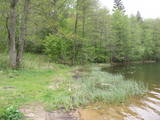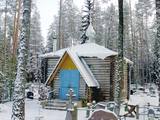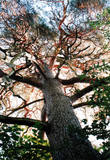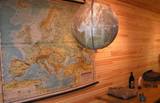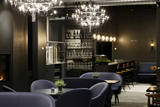| Nr | Nosaukums | Apraksts |
|---|---|---|
|
Ar niedrēm aizaudzis, piejūras pļavu, lagūnu, dūņainu ezeriņu un smilšainu sēkļu mozaīkas izraibināts Rīgas līča krasta posms starp Ainažiem un Kuivižiem – Randu pļavas – putniem un augiem nozīmīga vieta. Aizsargājams biotops un dabas liegums. Pļavu iepazīšanai izveidots putnu vērošanas tornis un dabas taka. Atrodas Ziemeļvidzemes biosfēras rezervātā.
|
||
|
Sākumā maršruts ved uz Ķemeru nacionālo parku, kurš ir bagāts ar floru, kā arī nacionālais parks piesaista ar saviem sēravotiem. Apciemojiet saimniecību, kas ir specializējusies uz augiem un tējām, un saimniece iepazīstina ar augu atšķirīgajām īpašībām un kā tos ir iespējams izmantot savai veselībai. Tālāk - apburošās Kuldīgas apskate un uz ugunskura pagatavota zivju zupa Pāvilostā. Izbrauciens pa upi ar tradicionālu zvejnieku laivu. Iespēja uzzināt, kā pagatavot maltītes, izmantojot savvaļas augus. Apskatiet Liepāju, tās smilšaino pludmali un aizraujošo militāro mantojumu. Dodieties uz Papes dabas parku, kur ir iespēja makšķerēt ezerā un uzzināt par tradicionālo zivju kūpināšanu. Apmeklējiet Rucavas tradīciju namu, kur iespējams izjust seno kultūras vidi un nobaudīt tradicionālo virtuvi. Pēc tam dodieties uz Šitaki sēņu audzētavu, kur tiek piedāvāts nogaršot šitaki sēņu ēdienus. Tālāk - zāļu tēju audzētāji un ražotāji, sēņošana mežā, bērzu sulu un dzirkstošā vīna darītava. |
||
|
Sasaļu meža nozīmīgākās dabas vērtības ir eitrofais Sasaļu ezers un neparastās izcelsmes sufozijas tipa ezers – Melnezers un tos ieskaujošās dažādu tipu meža audzes. Sasaļu ezers ir iecienīta atpūtas un peldvieta.
|
||
|
Misters Biskvīts ir kafejnīca pašā Siguldas centrā, iepretim dzelzceļa stacijai. Tajā tiek pasniegtas gan brokastis, gan salāti un uzkodas, gan dažādi pamatēdieni. Uzsvars tiek likts uz dabīgu un gardu konditorejas, kā arī kulinārijas izstrādājumu gatavošanu - gan kafejnīcas, gan dažādu pasākumu vajadzībām. Pieņem pasūtījumus arī līdzņemšanai. |
||
|
Desu un kūpinājumu ražošana no saimniecībā audzētām cūkām. Cūku barībā saimniecība izmanto pašu audzētus graudus (nav apstrādāti ar glifosātiem) un nemodificētās sojas pupiņas, kuras saimniecība pati izaudzē. Desu un kūpinājumu sastāvā ir gaļa un garšvielas. Kūpināšanas procesā izmato tikai dabīgo alkšņa malku. |
||
|
Bitenieks apsaimnieko ~ 300 bišu saimes, kuru vāktais medus ir godalgots dažādās nominācijās. Latvāņu medus, vietējās ogas ar medu un medus salmiņi bērniem (vienīgā vieta Latvijā). Interesanti var doties ekskursijā pa dravu, degustēt (10 medus veidi) un iegādāties biškopības produkciju. „Ekstremālā dravošana”, kuras laikā jāuzvelk bitenieka tērps, lai varētu čaklos kukaiņus iepazīt tuvumā. Vaska sveču liešana. |
||
|
Saimniecībā apskatāmi Latvijā reti audzētie angoras truši. Piedāvā ekskursiju ar stāstījumu, trušu vilnu, vilnas izstrādājumus (cimdi, zeķes) un konsultācijas. Bērni var rast saskarsmi ar dzīvniekiem un saimnieces uzraudzībā tos pabarot. |
||
|
Vaides Purvziedos lībiešu pēctecis, mežsargs Edgars Hausmanis iekārtojis lielisku meža dzīvnieku ragu muzeju. Ekspozīciju veido vairāk nekā 600 ragu, no tiem aptuveni 350 aļņu ragu. Kolekcijas eksponāti nav medību trofejas, bet atrasti ilggadējās mežsarga gaitās. Vēl apskatāma dabas aizsardzības ekspozīcija. Mājās arī šodien saimnieko senas lībiešu dzimtas pēcteči. |
||
|
Uz pāļiem veidotā koku laipu taka līkumo cauri Vēršupītes dumbrājiem (pārmitri platlapju meži), tādēļ visiespaidīgākie skati šeit ir vērojami tieši pavasara palos vai citos gadalaikos pēc lielām lietavām, kad mazā upīte iziet no krastiem un appludina dumbrājus lielākā platībā. Par teritorijas sezonālu applūšanu liecina arī daudzo alkšņu resnie sakņu kakli, kas nevilšus atgādina mangrovju audzes. Mitrie meži ir viens no sugu skaita ziņā daudzveidīgākajiem Latvijas biotopiem.
|
||
|
Nozīmīgs Rīgas līča krasta un aprimušu kāpu komplekss ar trīs lielo Latvijas upju – Lielupes, Daugavas un Gaujas grīvām un senām atpūtas vietu un kūrortu tradīcijām. Teritorijā izceļas ar skaistām piekrastes ainavām un ir viena no retajām jūrmalas pļavu atrašanās vietām Latvijas piekrastē. Dabas parka teritorijā ietilpst vairāki dabas liegumi – Lielupes grīvas pļavas, Vakarbuļļi, Daugavgrīva, Vecdaugava un Ummis (sk. nodaļu „Dabas liegumi”). Interesantākie dabas veidojumi ir Garciema kāpu amfiteātris un atsevišķas kāpas, piemēram, Legzdiņu un Slēpotāju kalns. Apmeklētājus piesaista dažādie kultūras un vēstures pieminekļi - Mangaļu pussalas fortifikācijas un militārās celtnes (no Krievijas cara līdz Padomju laiku beigām), Daugavgrīvas cietoksnis, Vecāķu kūrorts ar veco piekrastes apbūvi, Daugavgrīvas un Vecāķu pludmales. Rīgas tuvums un svarīgie rekreatīvie resursi ir arī iemesls teritorijas lielai antropogēnai noslodzei. Dabas parks piemērots aktīvam tūrismam (kājinieku, velo, ūdens, auto - moto), distanču slēpošanai, dabas (putnu) vērošanai, kultūras tūrismam, pasīvai atpūtai un izziņas tūrismam. Apmeklētāju vajadzībām izveidota Daugavgrīvas un Rožu kāpu dabas takas u.c. infrastruktūras elementi, kuru blīvums, apjomi un kvalitāte, diemžēl, ne vienmēr ir pietiekams. Diemžēl, šo nozīmīgo pierīgas rekreatīvo objektu nevar pilnvērtīgi iepazīt arī ar velosipēdu, jo nav izveidoti veloceliņi, kas atvieglotu un padarītu drošu braukšanu ar šo videi draudzīgo transporta līdzekli, kā tas, piemēram, ir Kuršu kāpās un pārējā Lietuvas piekrastes teritorijā! |
||
|
Maltas (Rozentovas) Visusvēto pareizticīgo baznīca uzcelta
1928. gadā. Tā ir koka guļbūve ar dubultiemlogu rāmjiem un sīpolveida
kupolu, fasādēs – stilizēts saules motīvs.
|
||
|
Viesu māja "Zaļā sala" atrodas pie Rēzeknes apvedceļa (A12). Saimniece gatavo Latgales ēdienus, izmantojot vietējos produktus. Sadarbojas ar vietējiem zemniekiem un zvejniekiem. Latviešu virtuve: Zemnieku brokastis, rupjmaizes kārtojums ar siļķi, rupjmaizes rika ar šprotēm, kartupeļi ar gaileņu mērci, melleņu zupa ar klimpām, cepti āboli, rabarberu deserts. Īpašais ēdiens: līdaka ar kūpinātu krūtiņu zaļajā mērcē. |
||
|
Latvijas resnākā parastā priede (Pinus sylvestris).
|
||
|
1982. gadā dibinātajā muzejā varēsiet iepazīties ar apriņķa sadzīvi sākot no 19. gadsimta otrās puses līdz pat tuvākajai nākotnei. Saimniecības šķūnī tiek rīkotas dažādas izstādes. Muzeja apkārtnes parkos 17 ha platībā var iepazīties ar 200 dažādu koku un krūmu sugām. Te var piedalīties dažādos tematiskajos pasākumos – maizes cepšanā, vietējo gadskārtu ieražu svētkos. Pie muzeja sākas arī Velises dabas un kultūras mantojuma mācību taka. |
||
|
Zoltners ir vieta, kur laika plūdums kļūst nebūtisks. Miers un atmosfēra, ko veido apkārtnes lauku ainava un pārdomātā arhitektūra, ir izcila vide, kurā aizmirst pilsētas rūpes un steigu. Šis gads iesācies ar pārmaiņām Zoltners restorānā. No februāra garšas piedzīvojumus turpinām ar jaunu šefpavāru Nauri Malāhovu. Nauris ir svaiguma un vietējo produktu piekritējs – spēj radīt esenci no labākā, ko var sniegt katra sezona. Baudu no garšas uzskata par savu misiju. Ēdienkarte veidota no atlasītiem ēdieniem, lai katram var pievērsties kā mākslas darbam. Garša ir dabiska - tīra un īsta, papildināta ar akcentiem, kas saskan, nekā lieka. Kad virtuvē darbojas jauns pavārs, tad viesošanās restorānā ir pavisam jauna pieredze. Tas ir tikpat kā apmeklēt jaunu restorānu. |
||
|
Iespaidīga koka celtne un izcils koka arhitektūras piemērs, kuru pamanīs katrs Plateļu apmeklētājs! Plateļu baznīca ir viens no Lietuvas vecākajiem koka dievnamiem. Pašreiz redzamais ir būvēts 1744. g., bet zvanu tornis – 1899. g. Dienvidos no baznīcas plešas Plateļu muižas parks. |
||
|
Pirts rituāli, zāļu tējas, izglītojoša pastaiga dabā, siena viesnīca. |
||
|
Kafejnīca - konditoreja "Ieviņa" atrodas Kandavas centrā netālu no Tirgus laukuma. Piedāvājumā cepumi, kūciņas, tortes, sklandrauši, pīrādziņi u.c. |
||
|
Linezera dabas takā apskatāms ezers, kurš mēdz pazust pazemē. Apmeklējums saskaņojams ar zemes īpašnieku. |
||
|
Jau no 1820. gada cilvēki ir brūvējuši igauņu alu, izmanotojot vietējās izejvielas, kā ūdeni, rauhu un citus. Nosaukums - Saku Alus Darītava - ir nācis no iepriekšējās darītavas, kas darbojās līdz 1992. gadam. Šeit atrodas arī muzejs, kur var apskatīt, kā alus ceļš ir mainījies cauri gadiem. ir iespējams arī degustēt tikko brūvētu alu. Nepilngadīgajiem piedalīšanās tūrē ir aizliegta. |
||


